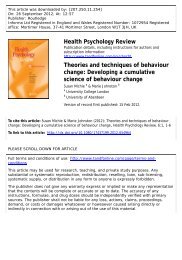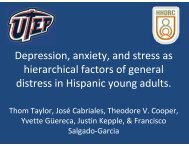Implementation of the VA Stepped Care Model of Pain Management
Implementation of the VA Stepped Care Model of Pain Management
Implementation of the VA Stepped Care Model of Pain Management
- No tags were found...
Create successful ePaper yourself
Turn your PDF publications into a flip-book with our unique Google optimized e-Paper software.
PROJECT STEP<strong>Implementation</strong> <strong>of</strong> <strong>the</strong> <strong>VA</strong> <strong>Stepped</strong> <strong>Care</strong><strong>Model</strong> for <strong>Pain</strong> <strong>Management</strong>Patricia H. Rosenberger, Ph.D. & Robert Kerns, Ph.D.<strong>VA</strong> Connecticut Healthcare SystemDepartment <strong>of</strong> Psychiatry, Yale School <strong>of</strong> Medicine
PROJECT STEP Presentation Goals:Provide background and overview <strong>of</strong> ProjectSTEPPresent baseline assessment resultsNeeds Assessment / Developmental FormativeEvaluationOutcomes: Primary <strong>Care</strong> quality indicators
Project Step: BackgroundIn 2009, VHA advocated a stepped care approachto pain management as a best practice model<strong>Stepped</strong> <strong>Care</strong> <strong>Model</strong>Broad, population-based health interventions that promotescreening, assessment, and management <strong>of</strong> health problemsLow intensity interventions first, followed by more intensive,specialized, and individually tailored approaches if necessaryEmpirically supported Collaborative care for chronic pain (Dobscha, 2009) Modest improvement in outcome measures such as pain-related disability,depression O<strong>the</strong>r chronic health challenges (e.g., depression, alcoholism, tobaccocessation VHA Mandate: Adopt <strong>Stepped</strong> <strong>Care</strong> <strong>Model</strong> <strong>of</strong> <strong>Pain</strong><strong>Management</strong> (SCM-PM) as single standard <strong>of</strong> pain care VHA Goal: Full implementation within 5 years
Project Step: Baseline Survey Responses• Content analysis revealed following <strong>the</strong>mes:PRIMARY CARE PCPs PRIMARY CARE STAFF SPECIALTY CLINICSTAFFRewards/Facilitators Rewards/Facilitators Rewards/FacilitatorsSeeing patients improvefunctioning is gratifyingKnowledge that actioncan make a positivedifferenceGood communicationbetween patient -providerRelationship building (withpatient)Tapering <strong>of</strong>f opiatesAvailability <strong>of</strong> CAMResourcesMultidisciplinary teams /Team approach to careMultidisciplinaryapproach /team support
Project Step: Baseline Survey ResponsesPRIMARY CARE PCPsPRIMARY CARESTAFFSPECIALTYCLINIC STAFFBarriers Barriers BarriersInadequacies inEducationPersonal barriers(knowledge deficits)Communication:Patient – providerLack <strong>of</strong> consultantsupportProblem complexitySkepticism about currenttreatmentsSystem barriers:restrictions onpharmaceuticalformulary, handwrittenopiate prescriptionsPatient barriers(resistance, noncooperation,aberrantbehavior)Skepticism towardpatients and providersSystem barriers: limitedhours <strong>of</strong> operation,distance, deficient paineduational material,large provider panelsCoordinationamong clinicsPatient attitudes /beliefs about painmanagementSystem barriers:Resourcelimitations,demand exceedscapacity
Baseline Assessment: Quality IndicatorsHypo<strong>the</strong>sis: Successful implementation <strong>of</strong> SCM-PM will bereflected in change in pr<strong>of</strong>essional behavior at <strong>the</strong> level <strong>of</strong>primary careIncreased knowledge and competency in managing pain conditionsPrimary <strong>Care</strong> <strong>Pain</strong> Documentation: Baseline examination <strong>of</strong>primary care pain management quality indicatorsAssessed pain assessment, treatment planning, pain reassessmentthrough expert coding <strong>of</strong> PCP progress notesRandomly selected 2 samples <strong>of</strong> 150 Veterans within baseline year:Veterans reporting moderate to severe pain (score ≥ 4 on <strong>VA</strong> NRS)Veterans receiving chronic opioid <strong>the</strong>rapy (≥ 90 days)Interrater reliability kappas supported adequate reliability
Project Step Baseline Chart Review:Comparison <strong>of</strong> <strong>Pain</strong> Documentation in Chronic OpioidPrescription Group Versus <strong>Pain</strong> Score ≥ 4 Group
<strong>VA</strong>CHS Primary <strong>Care</strong> Patient Visits Primary care and pain: Examined trends in pain scores assessed atprimary care visits through administrative data
Project Step: Trends in Veteran painreporting over 10 years in primary care
Project Step Primary <strong>Care</strong> OpioidMedication Data Method: Used administrative and electronicdata to determine opioid medication use in<strong>VA</strong>CHS & guide line concordant care During baseline year (July 2009 – June 2010) 1616 Veterans received an opioid, <strong>of</strong> which 597(36.9%) received 90 or more days. <strong>Management</strong> <strong>of</strong> Chronic Opioid Therapy Among those prescribed an opioid <strong>of</strong> 90+ days,(63.2%) had a valid opiate initiation agreement onrecord82.4% had a urine tox screen ordered within year
Project Step: Facilitating<strong>Implementation</strong> <strong>of</strong> <strong>the</strong> SCM-PMNeeds Assessment: Inadequacies in trainingSponsored a day workshopDeveloped and distributed pain brochure for primary careto distribute to patientsQuality Indicators:Templates for pain assessment and opioid initiation andfollow up now available to PCP’s in medical recordPresentations to all primary care clinics on how to usetemplatesYearly assessments ongoing to determine change
















